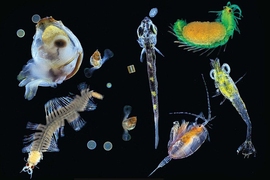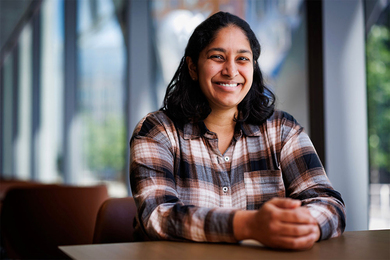Walk down MIT’s Infinite Corridor, or through some lesser-known hallways, or even many offices around campus, and you’ll find framed prints of some of Harold “Doc” Edgerton’s famous high-speed photography: a bullet through an apple, a pole vaulter arching his body with athletic perfection, a milk drop exploding in mid-air.
As the instructor for 6.163 (Strobe Project Lab), Edgerton Center Associate Director Jim Bales continues Edgerton’s legacy in high-speed imaging. And Keith Ellenbogen, a Center for Art, Science and Technology (CAST) Visiting Artist, has set up camp in shared office space with Bales. His focus: high-speed marine photography.
Ellenbogen’s work has received international acclaim in underwater photography and video, with a focus on conservation efforts. His residency with CAST spans this semester and the upcoming Independent Activities Period (IAP), during which he is working closely with Bales and associate professor of physics Allan Adams to create emotionally charged underwater photography using high-speed imaging and other technologies. Keith hopes to teach students about photography, especially the ways environmental photography can inspire conservation efforts. He recently answered a few questions about his residency.
Q: Where did you get your start in underwater photography?
A: I grew up in Newton, Massachusetts, and started volunteering at the [New England] Aquarium when I was 16. Actually, I got my start in diving and learning about animals there, especially learning about each animal’s role in the ocean. When I became interested in photography, naturally I began experimenting there first, and my friends and mentors who helped me get started were crucial to the start of my career.
Q: How did you get into the high-speed imaging projects with Allan Adams?
A: Well, fast-forward a number of years, and long story short, Allan was really interested in my work — and vice versa — when we happened to meet at an event in 2012. He invited Jim [Bales] and myself to his house for brunch, and it became that cool thing when you put some heads together and awesome ideas come out of it. Jim had the imaging expertise, advice, and all the connections in the high-speed world. We were so excited to hear him say, “These ideas sound cool. Let’s do it!”
Q: Can you describe a bit how you and Adams play off of each other for the work?
A: Absolutely – I couldn’t have this residency [at MIT] without this collaboration with Allan, where we’re essentially pushing each other to the best we can do. Allan, of course, knows a crazy amount about quantum mechanics and theoretical physics. One idea we had a couple of years ago was to high-speed photograph cuttlefish. When cuttlefish strike their prey, they can move incredibly fast, but actually stop right before they reach prey. Otherwise they’d pierce through it. But you can’t see this with the human eye. Allan knew all about it and about how their motions can be described by physics, and said, why not try using high-speed imaging to illuminate what we can’t see? I was really excited by it, so we went down to the aquarium to try this. In the end, after a long time setting up and shooting and shooting again, we got these brilliant snaps of each part of the cuttlefish’s movement.
Q: It must be hard to get good shots! How do you do it?
A: Yeah, it takes at least weeks! Often months. There’s getting the equipment, setting it up, getting crew to travel over. In the aquarium, I can’t go in the water with the strobe imaging equipment, so there’s the added difficulty of waiting for animals, without being able to go towards them.
One time we wanted to shoot the Van de Graff generator in the Museum of Science shooting sparks. It happens in real life in a millionth of a second, so to watch the spark form we needed a camera that can take 10 million frames per second. Ten million requires very special equipment! We usually only have cameras that capture thousands of frames per second. This one took a couple of months to get done. But we got some crazy, just the coolest photos. I think we all got goosebumps when we saw the lines of sparks crawling through the air in the photo. Another example of the work that came from Allan and I brainstorming, bouncing ideas off of one another.
Also, as a photographer, I have to think about what to go for, how long to wait, especially when I’m out in the field waiting for animals to do something like catch food. Sometimes I only have a couple of days on a project, so strategizing comes into play. This is one of those things that gets easier with practice and experience, but there’s always a stressful, tense sort of thrill whenever I’m on a project.
Q: Tell me a bit about what you’re hoping to do at MIT.
A: The biggest is teaching the IAP course with Allan: Underwater Conservation Photography. We start with the basics of photography, and at the end we’re taking the class to Belize to shoot in the field. I want to teach how to show the world through the lens and influence conservation with it. I love teaching, and I think Allan and I will have a ton of fun with it. I hope the students can get a lot out of it too.
Another, of course, is being around the people. Jim is an invaluable mentor, and has so many contacts in the imaging world. Being in the Edgerton Center itself around the history of photography that started from here is inspiring.
Q: What would you tell someone who asks you how photographs influence conservation? What is something about it that you’d want all of us to know?
A: It’s been a big part of my career. It’s the aesthetic of a photo that makes it easy for people to relate to, and once that emotional connection is made, people will care; they’ll be moved and feel compelled to do something. I think photos have such huge potential because everything about them — composition, subject matter, etc. — can be learned and used to the best way to captivate the audience. And now, using the intersection of technology and photography, we uncover yet another world to learn new things: seeing things we literally could not before, and learning new things about animals and giving them a voice that they didn’t have before. I’d say it’s a very powerful tool.













